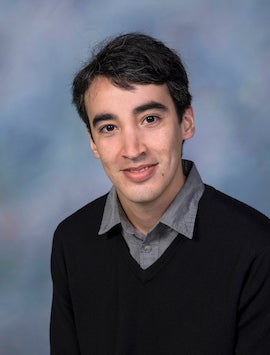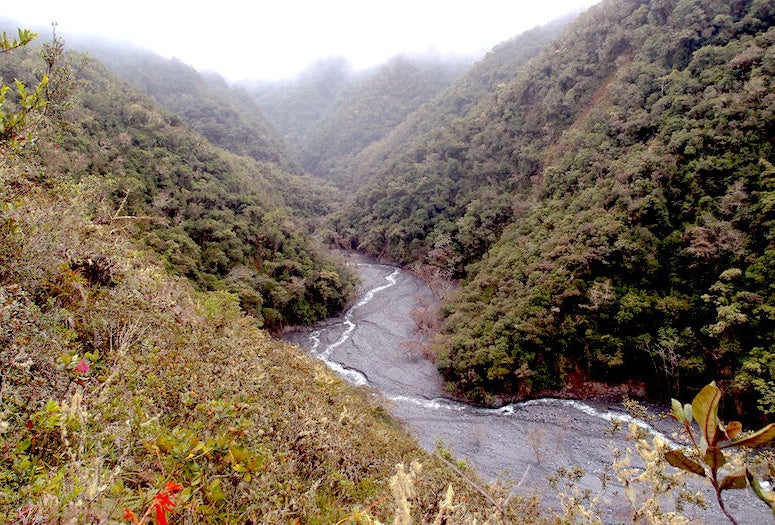As the primary element of life on our planet, carbon is constantly journeying from living creatures down into the Earth’s crust and back up into the atmosphere, but until recently, quantifying this journey was virtually impossible.
To help unravel the mystery of how the Earth cycles fossil carbon, Rice University’s Mark Torres and collaborators studied the chemistry of a river system extending from the Peruvian Andes to the Amazon floodplains. Together with collaborators from five other institutions, Torres helped show that high rates of carbon breakdown persist from mountaintop to floodplain, as the carbon bound in rock that was once prehistoric ocean floor gets released into the atmosphere through erosion and weathering.
According to a study published in PNAS, the researchers used rhenium ⎯ a silvery-gray, heavy transition metal ⎯ as a proxy for carbon. Understanding the Earth’s natural, pre-anthropogenic carbon cycle offers valuable insights into the planet’s history and its response to current climate challenges.
“The purpose of this research was to quantify the rate at which Earth naturally releases carbon dioxide into the atmosphere and find out whether this process varies across different geographic locations,” Torres said.
Traditionally, understanding this process has been challenging as it involves complex chemical reactions that transform rocks into gases like carbon dioxide, making it difficult to quantify.

“This research used a newly-developed technique pioneered by Robert Hilton and Mathieu Dellinger that relies on a trace element ⎯ rhenium ⎯ that’s incorporated in fossil organic matter,” Torres said. “As plankton die and sink to the bottom of the ocean, that dead carbon becomes chemically reactive in a way that adds rhenium to it.”
Over vast periods of time, geological processes can cause the rock on the ocean floor to be thrust to the Earth’s surface as mountain ranges and the ancient carbon locked in the rock gets slowly released in the atmosphere. As this happens, rhenium is left behind, which can be measured in water.
Unlike other elements in fossil carbon ⎯ such as nitrogen or phosphorus ⎯ which are taken up by plants or become part of other chemical or biological processes, rhenium is relatively inert, making it a good tool for gauging how much carbon gets released into the atmosphere from the Earth’s crust.
“Organisms don’t care about it ⎯ it’s not a nutrient,” Torres said. “It just passively gets incorporated into rivers, where we can measure it. A good proxy is one that only responds to the process you’re trying to study.
“You have to know a lot about rhenium as an element and its chemistry and the environment to be able to interpret it in this way. There is a lot of interpretive work that has had to come before these measurements that allows us to say that the only host for this element is the fossil carbon evaporated into the atmosphere.”
The Rio Madre de Dios basin was an ideal location for studying this question because it provided a natural gradient from the heights of one of the tallest mountain ranges down to the floodplains of the world’s largest river by volume. Moreover, the rock types exposed at this site are carbon-rich shales, which Torres says is exactly what you would want to study in this case.
“I’m very excited about this tool,” Torres said. “Rice students have deployed this same method in our lab here, so now we can make this kind of measurement and apply it at other sites. In fact, as part of current research funded by the National Science Foundation, we are applying this technique in Southern California to learn how tectonics and climate influence the breakdown of fossil carbon.”

By grasping the slow processes that govern our planet’s carbon cycle, scientists can build more accurate climate models and work toward more effective strategies of mitigating the impact of anthropogenic carbon emissions.
Torres is an assistant professor of Earth, environmental and planetary sciences at Rice. Hilton, a professor of sedimentary geology at the University of Oxford, and Dellinger, a researcher at Université Savoie Mont Blanc, are lead authors on the study.
The research was supported by the European Research Council Starting Grant — ROC-CO2 (678779), the European Union COFUND/Durham Junior Research Fellowship (267209) and the National Science Foundation (1455352, 1851309, 20000097).
- Peer-reviewed paper:
-
“High rates of rock organic carbon oxidation sustained as Andean sediment transits the Amazon foreland-floodplain” | PNAS | DOI: 10.1073/pnas.2306343120
Authors: Mathieu Dellinger, Robert G. Hilton, J. Jotautas Baronas, Mark A. Torres, Emily I. Burt, Kasey E. Clark, Valier Galy, Adan Julian Ccahuana Quispe and A. Joshua West
https://www.pnas.org/doi/full/10.1073/pnas.2306343120 - Image downloads:
-
https://news-network.rice.edu/news/files/2023/11/180207_Mark_Torres-0002.jpg
CAPTION: Mark Torres is an assistant professor of Earth, environmental and planetary sciences at Rice University. (Photo by Gustavo Raskosky/Rice University)https://news-network.rice.edu/news/files/2023/11/P8161927.jpg
CAPTION: The Rio Madre de Dios basin was an ideal location to study how the Earth cycles fossil carbon. (Photo courtesy of Mark Torres/Rice University)https://news-network.rice.edu/news/files/2023/11/Peru_Valley.jpg
CAPTION: The Rio Madre de Dios basin is rife with carbon-rich shales, the ideal rock type to study for the purposes of the project. (Photo courtesy of Mark Torres/Rice University)
- Related stories:
-
DOE backs Rice study of how soils store carbon:
https://news.rice.edu/news/2023/doe-backs-rice-study-how-soils-store-carbon
Climate warming reduces organic carbon burial beneath oceans:
https://news.rice.edu/news/2023/climate-warming-reduces-organic-carbon-burial-beneath-oceans
Mark Torres wins Geochemical Society’s Clarke Award:
https://news.rice.edu/news/2021/mark-torres-wins-geochemical-societys-clarke-award - Links:
-
Torres lab: https://torres-lab.github.io/
Earth, environmental and planetary sciences department: https://eeps.rice.edu/
Wiess School of Natural Sciences: https://naturalsciences.rice.edu/
- About Rice:
-
Located on a 300-acre forested campus in Houston, Rice University is consistently ranked among the nation’s top 20 universities by U.S. News & World Report. Rice has highly respected schools of architecture, business, continuing studies, engineering, humanities, music, natural sciences and social sciences and is home to the Baker Institute for Public Policy. With 4,574 undergraduates and 3,982 graduate students, Rice’s undergraduate student-to-faculty ratio is just under 6-to-1. Its residential college system builds close-knit communities and lifelong friendships, just one reason why Rice is ranked No. 1 for lots of race/class interaction, No. 2 for best-run colleges and No. 12 for quality of life by the Princeton Review. Rice is also rated as a best value among private universities by Kiplinger’s Personal Finance.

